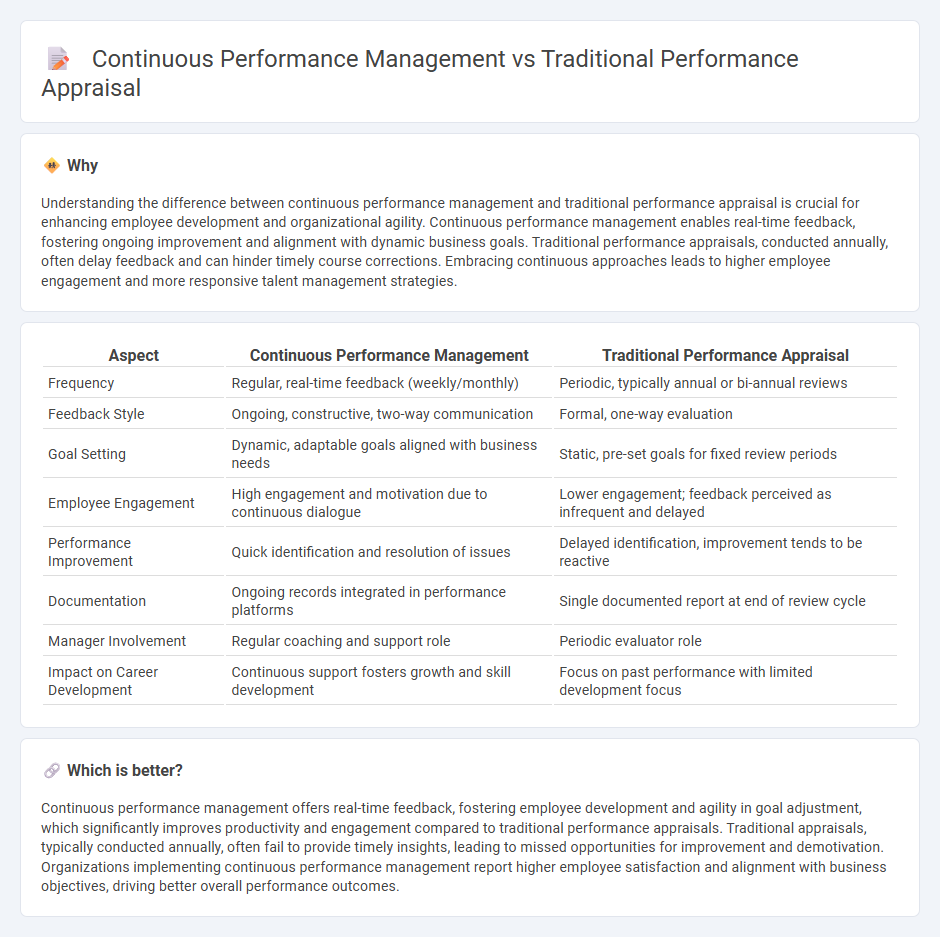
Continuous performance management fosters real-time feedback, goal alignment, and employee development throughout the year, contrasting sharply with traditional performance appraisals that often rely on annual reviews and retrospective evaluation. Data shows organizations implementing continuous methods experience higher employee engagement and more agile performance improvements. Explore how continuous performance management can transform your organizational outcomes and drive sustained success.
Why it is important
Understanding the difference between continuous performance management and traditional performance appraisal is crucial for enhancing employee development and organizational agility. Continuous performance management enables real-time feedback, fostering ongoing improvement and alignment with dynamic business goals. Traditional performance appraisals, conducted annually, often delay feedback and can hinder timely course corrections. Embracing continuous approaches leads to higher employee engagement and more responsive talent management strategies.
Comparison Table
| Aspect | Continuous Performance Management | Traditional Performance Appraisal |
|---|---|---|
| Frequency | Regular, real-time feedback (weekly/monthly) | Periodic, typically annual or bi-annual reviews |
| Feedback Style | Ongoing, constructive, two-way communication | Formal, one-way evaluation |
| Goal Setting | Dynamic, adaptable goals aligned with business needs | Static, pre-set goals for fixed review periods |
| Employee Engagement | High engagement and motivation due to continuous dialogue | Lower engagement; feedback perceived as infrequent and delayed |
| Performance Improvement | Quick identification and resolution of issues | Delayed identification, improvement tends to be reactive |
| Documentation | Ongoing records integrated in performance platforms | Single documented report at end of review cycle |
| Manager Involvement | Regular coaching and support role | Periodic evaluator role |
| Impact on Career Development | Continuous support fosters growth and skill development | Focus on past performance with limited development focus |
Which is better?
Continuous performance management offers real-time feedback, fostering employee development and agility in goal adjustment, which significantly improves productivity and engagement compared to traditional performance appraisals. Traditional appraisals, typically conducted annually, often fail to provide timely insights, leading to missed opportunities for improvement and demotivation. Organizations implementing continuous performance management report higher employee satisfaction and alignment with business objectives, driving better overall performance outcomes.
Connection
Continuous performance management enhances traditional performance appraisal by providing real-time feedback and ongoing communication, which improves goal alignment and employee development. Traditional appraisals offer structured evaluations, while continuous methods ensure timely adjustments and greater employee engagement throughout the review cycle. Together, these approaches create a comprehensive performance management system that drives productivity and supports organizational growth.
Key Terms
Annual Review
Traditional performance appraisal centers on an annual review that summarizes employee performance, often emphasizing past achievements and setting goals for the upcoming year. In contrast, continuous performance management involves ongoing feedback, regular check-ins, and real-time coaching to align employee development with organizational objectives. Explore detailed comparisons to understand which approach best suits your business needs.
Real-time Feedback
Traditional performance appraisal relies on periodic evaluations, often conducted annually, which can delay feedback and hinder immediate improvements. Continuous performance management emphasizes real-time feedback, fostering ongoing communication, timely adjustments, and enhanced employee development. Explore more about how real-time feedback transforms productivity and engagement in modern workplaces.
Goal Setting
Traditional performance appraisal relies on annual goal setting, often resulting in infrequent feedback and limited alignment with evolving business objectives. Continuous performance management emphasizes ongoing goal refinement, real-time feedback, and dynamic adjustments to ensure individual and team objectives stay relevant and achievable. Explore how continuous goal setting can transform employee development and drive organizational success.
Source and External Links
360 Degree Feedback vs Traditional Performance Review - Traditional performance appraisals are a manager-driven, top-down process focusing on evaluating past performance against predefined goals in annual or semi-annual reviews with limited feedback sources and potential bias.
What are the Traditional Methods of Performance Appraisal? - Traditional appraisal methods include confidential reports, essay method, ranking, and paired comparison, emphasizing supervisor evaluations and ranking employees usually in an annual cycle.
Performance Management: Traditional and Progressive ... - The traditional performance management process is top-down and linear, setting objectives early in the year and evaluating employees annually against specific performance standards.
 dowidth.com
dowidth.com